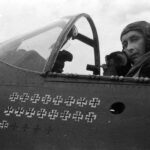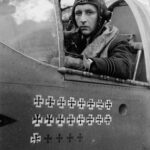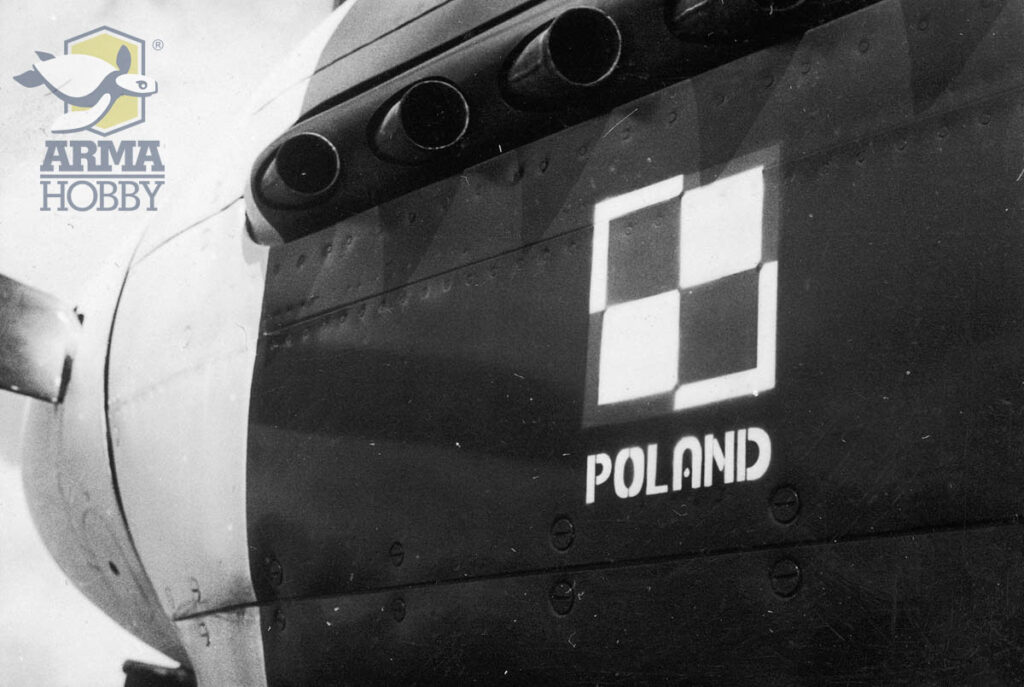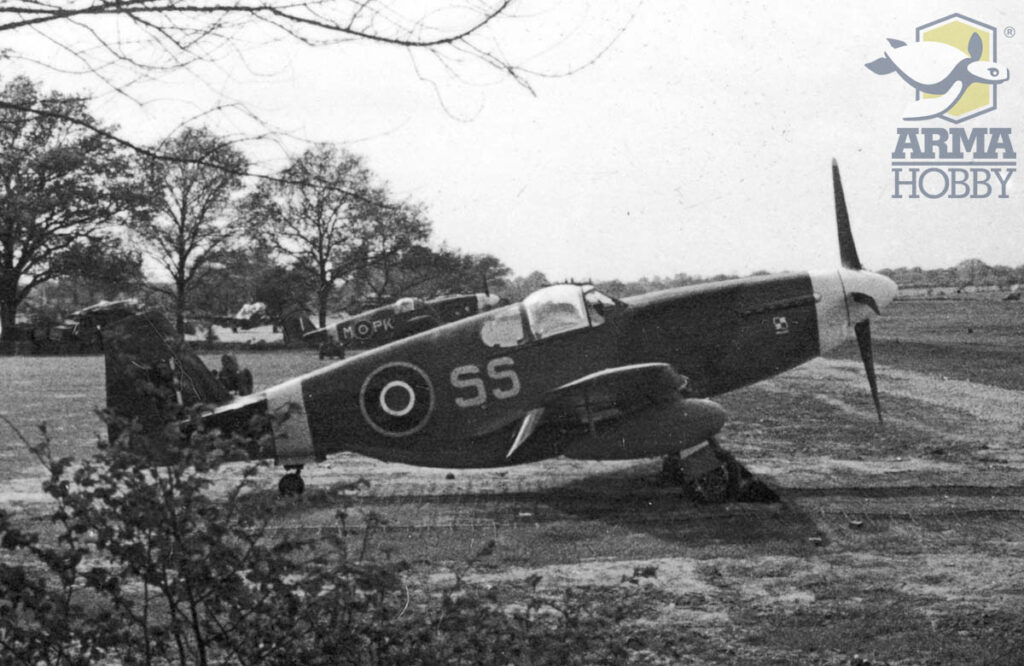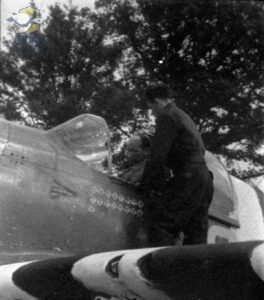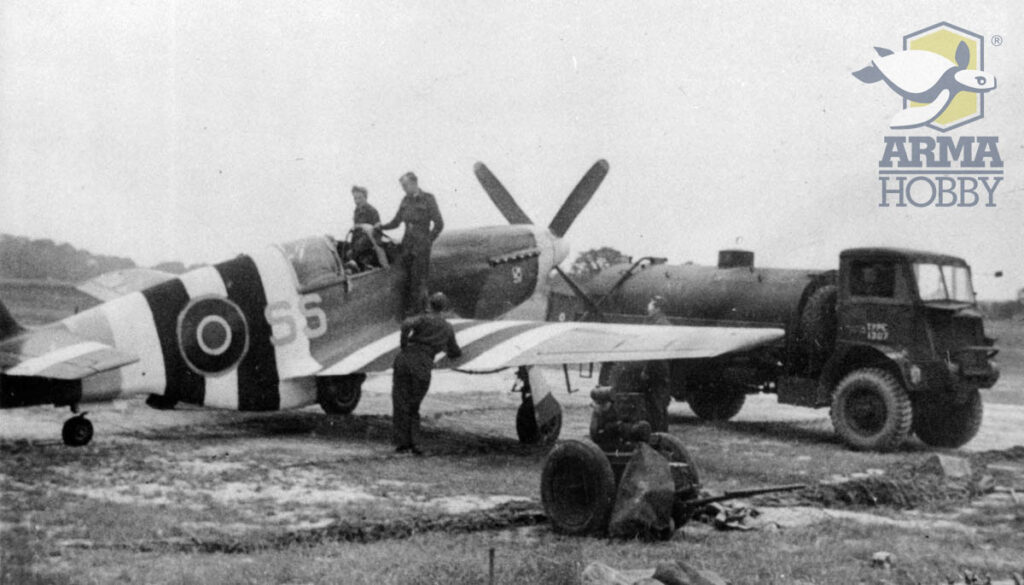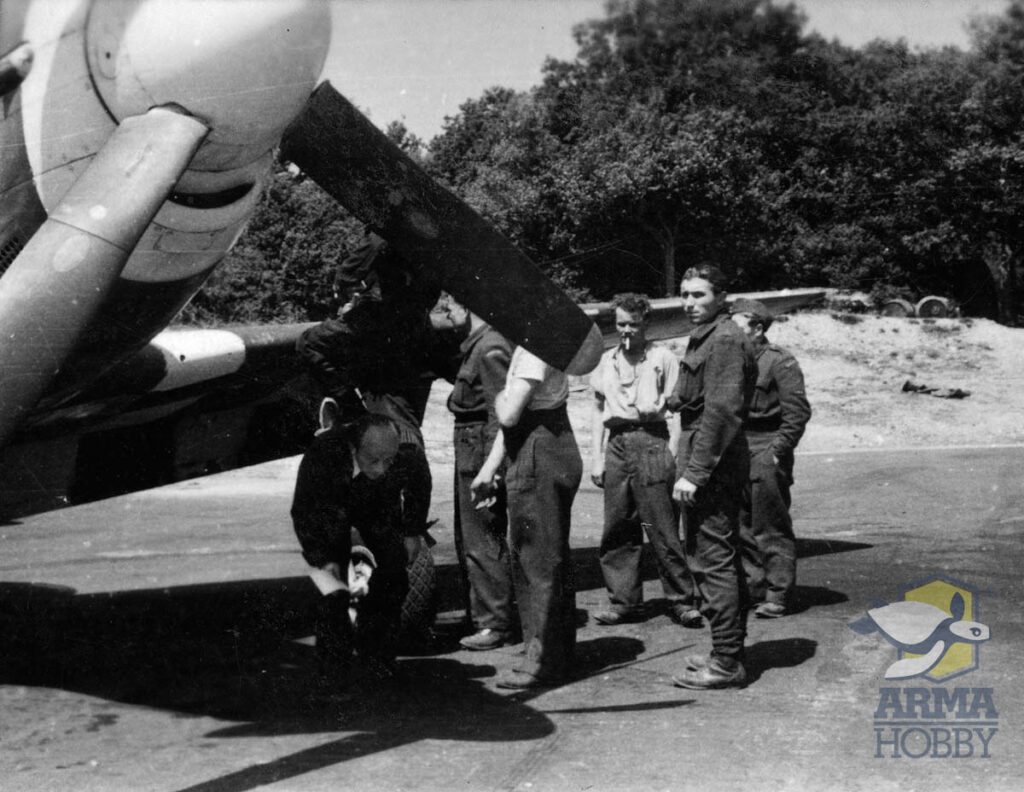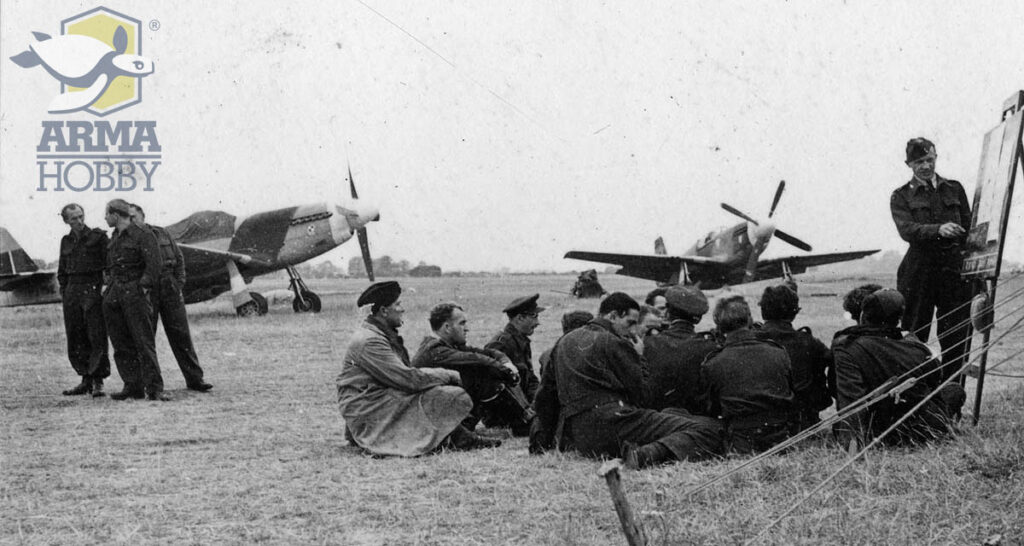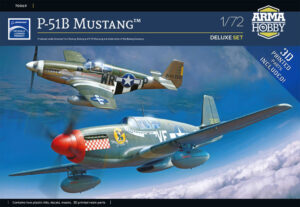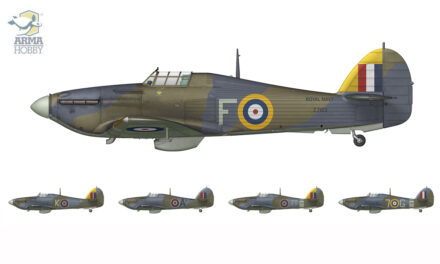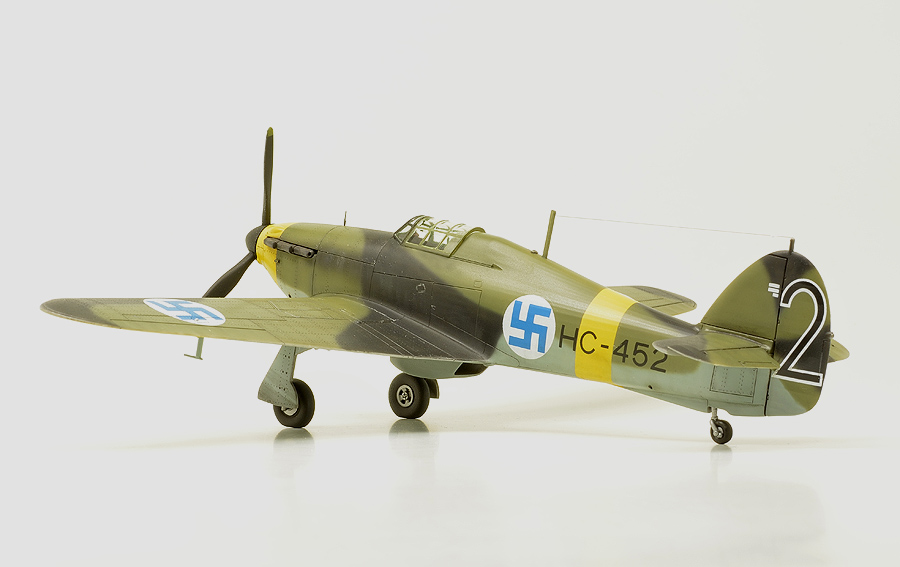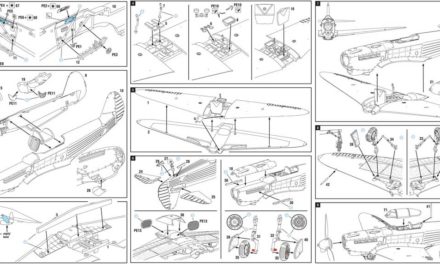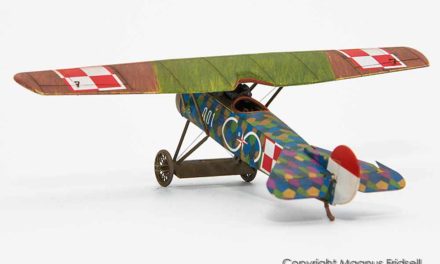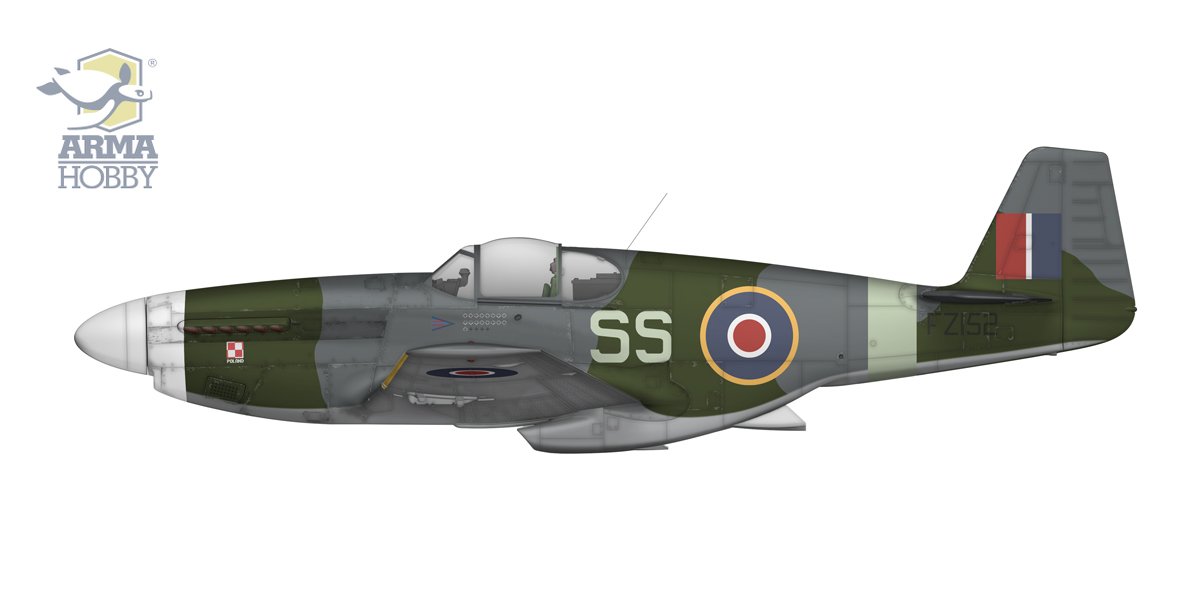
On 8 April 1944, North American Mustang III no. FZ152 (or P-51B-5NA no. 43-6533) was delivered to No. 133 Wing from No. 84 Group Support Unit (84 GSU) to be used as the Wing Leader’s personal machine. It was ferried to the wing’s airfield at Coolham by F/Lt Zygmunt Jeliński, a pilot of No. 306 Squadron. Jeliński was not the first Pole to fly FZ152, though. This Mustang had been delivered to No. 84 GSU on 25 March 1944 by F/Lt Roman Hrycak, then serving with No. 2 Aircraft Delivery Flight RAF.
The aircraft had been factory-finished in the RAF Temperate Land scheme, consisting of areas of dark greyish brown and dark greyish green on upper surfaces, and light grey-greenish underneath (the American paints used were not exact equivalents of the Dark Earth, Dark Green and Sky used in the RAF). Upon delivery to the RAF, the aircraft was repainted in the Day Fighter scheme: the brown areas were oversprayed with Ocean Grey and the pale underside was repainted with Medium Sea Grey. It is not known whether the American dark green hue was left on upper surfaces or repainted with the standard British Dark Green.
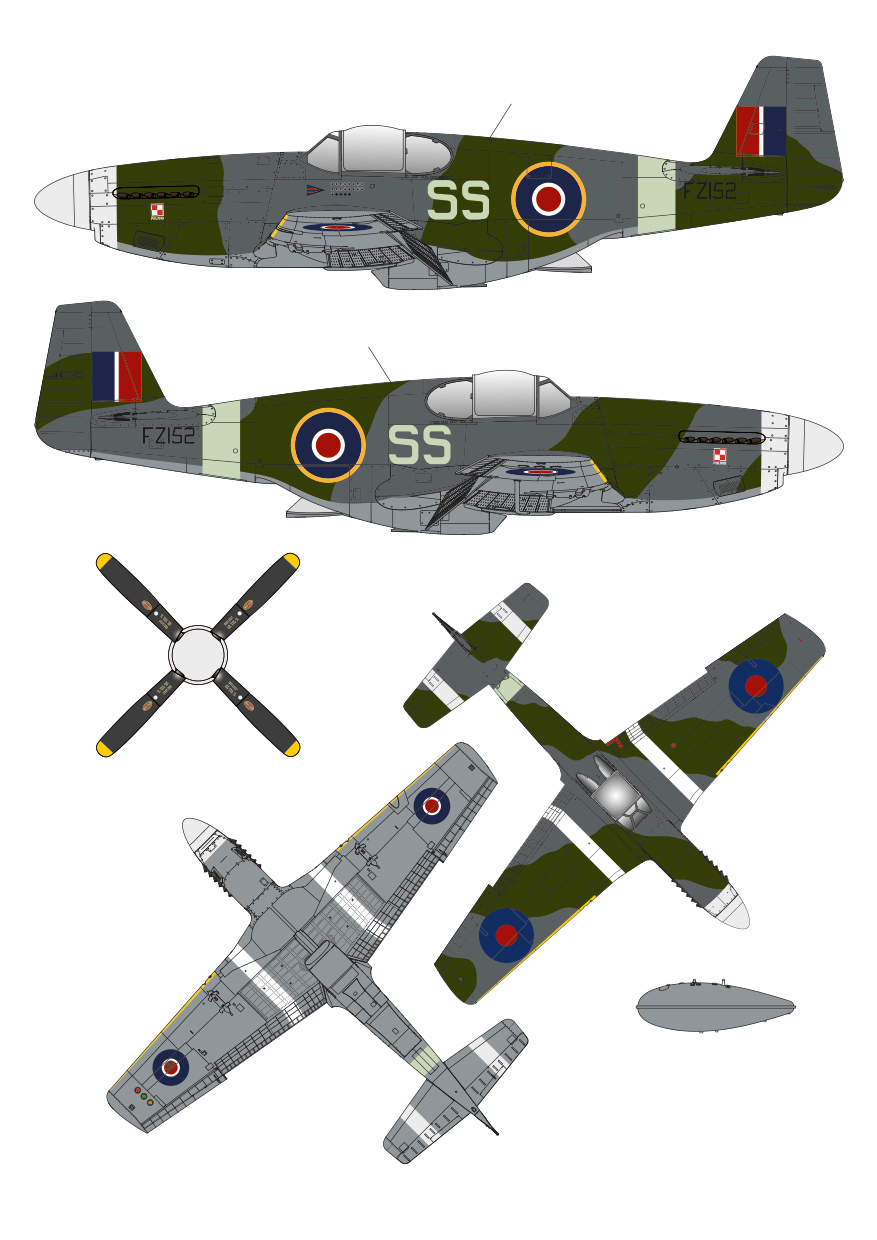
Three views of W/Cdr Stanisław Skalski in the cockpit of Mustang III FZ152 SS, taken in April 1944 at Coolham. One of them appeared on the cover of the Polish Air Force magazine ‘Skrzydła’ (‘Wings’) issued in mid-June 1944.
The aircraft also received British quick recognition markings. The band in Sky around the rear fuselage were standard on all day fighters. The white bands at the roots of the wings and tailplanes plus a white propeller spinner and front part of the nose were only applied on Mustangs, due to the similarity of this aircraft and the Messerschmitt 109. The RAF serial number (applied on the rear fuselage in the USA and then overpainted during the application of the Sky band) was re-applied below the tailplane.
Stanisław Skalski
 At the beginning of April 1944, W/Cdr Stanisław Skalski took over the position of the Wing Leader (W/Cdr Flying) with No. 133 Wing. Born on 27 November 1915 at Labushna near Kodyma (now in Ukraine), son of Szymon and Józefa née Biernat. W 1933 he commenced studies at the School of Political Arts in Warsaw. In May 1934 he completed a gliding course, and in April 1935 a powered flying course. In 1936 he joined the Polish Air Force College at Dęblin. He was commissioned on 15 October 1938 and posted to the 142nd Fighter Flight of the 4th Air Regiment in Toruń. In September 1939 he flew with the 142nd Flight in ‘Pomorze’ Army aviation. He emerged from the campaign as the top-scoring Polish pilot. Following the Soviet invasion, on 18 September he went to Rumania, and then by sea to France. He went to Britain in January 1940. On 3 August 1940 he was posted to the newly formed Polish No. 302 Squadron, but on 12 August 1940 he was posted away to Blackpool. Two weeks later, on 26 August 1940 he was posted to No. 501 Squadron RAF. On 5 September 1940 he was shot down over Canterbury in Hurricane V6644 SD-B, wounded and burnt. Following hospital treatment, he returned to No. 501 Squadron. On 25 February 1941 he was posted to No. 306 Squadron PAF as an Operations Room controller, and in late April he became a pilot of the squadron. On 15 August 1941 he was appointed the ‘B’ Flight commander. On 1 March 1942 he was reposted to No. 316 Squadron PAF as ‘B’ Flight commander. On 2 May 1942 he was appointed to command No. 317 Squadron PAF. From November 1942 he was an instructor at the Polish Fighter School attached to No. 58 Operational Training Unit RAF at Balado Bridge. In February he was appointed the S/Ldr Flying of the Polish Combat Team (sent to Africa under W/Cdr Tadeusz Rolski). At this post he took part in the African campaign from March until June 1943. He then volunteered to fly with an RAF unit in the Mediterranean and on 30 June he was posted to No. 601 Squadron RAF, which he subsequently commanded from 15 July until 20 October 1943 (becoming the second Pole to command a British squadron). Following his return to Britain, on 12 December 1943 he became the W/Cdr Flying of No. 131 (Polish) Wing. From April to July 1944 he held a similar post in No. 133 (Polish) Wing. In October 1944 he went to study at the Command and General Staff College, Fort Leavenworth, USA. Upon return he was posted on 25 February 1945 as a staff officer to No. 11 Group RAF. From February 1946 he was staff officer at the HQ British Air Forces of Occupation in Germany. He was the top-scoring Polish Air Force pilot during World War II. His decorations included the Silver and Golden Cross of the Order of Virtuti Militari, the Cross of Valour and three bars, the British DSO, and DFC and two bars (as the only Pole and one of just nine WW2 pilots to earn the DFC three times). On 8 June 1947 he returned to the communist-controlled Poland and in July of that year he commenced service with the Polish Air Force HQ. He was arrested on 4 June 1948, and subsequently sentenced to death under fabricated charges of spying, but the sentence was commuted to life imprisonment. He was released and rehabilitated in April 1956. In 1957 he returned to the Polish Air Force. Later he was active in sports aviation, he became the Secretary General and the Vice-President of the Polish Aero Club. In October 1988 he was promoted to the rank of general (in retirement). He died on 12 November 2004 and was buried on 19 November at the Powązki Military Cemetery in Warsaw.
At the beginning of April 1944, W/Cdr Stanisław Skalski took over the position of the Wing Leader (W/Cdr Flying) with No. 133 Wing. Born on 27 November 1915 at Labushna near Kodyma (now in Ukraine), son of Szymon and Józefa née Biernat. W 1933 he commenced studies at the School of Political Arts in Warsaw. In May 1934 he completed a gliding course, and in April 1935 a powered flying course. In 1936 he joined the Polish Air Force College at Dęblin. He was commissioned on 15 October 1938 and posted to the 142nd Fighter Flight of the 4th Air Regiment in Toruń. In September 1939 he flew with the 142nd Flight in ‘Pomorze’ Army aviation. He emerged from the campaign as the top-scoring Polish pilot. Following the Soviet invasion, on 18 September he went to Rumania, and then by sea to France. He went to Britain in January 1940. On 3 August 1940 he was posted to the newly formed Polish No. 302 Squadron, but on 12 August 1940 he was posted away to Blackpool. Two weeks later, on 26 August 1940 he was posted to No. 501 Squadron RAF. On 5 September 1940 he was shot down over Canterbury in Hurricane V6644 SD-B, wounded and burnt. Following hospital treatment, he returned to No. 501 Squadron. On 25 February 1941 he was posted to No. 306 Squadron PAF as an Operations Room controller, and in late April he became a pilot of the squadron. On 15 August 1941 he was appointed the ‘B’ Flight commander. On 1 March 1942 he was reposted to No. 316 Squadron PAF as ‘B’ Flight commander. On 2 May 1942 he was appointed to command No. 317 Squadron PAF. From November 1942 he was an instructor at the Polish Fighter School attached to No. 58 Operational Training Unit RAF at Balado Bridge. In February he was appointed the S/Ldr Flying of the Polish Combat Team (sent to Africa under W/Cdr Tadeusz Rolski). At this post he took part in the African campaign from March until June 1943. He then volunteered to fly with an RAF unit in the Mediterranean and on 30 June he was posted to No. 601 Squadron RAF, which he subsequently commanded from 15 July until 20 October 1943 (becoming the second Pole to command a British squadron). Following his return to Britain, on 12 December 1943 he became the W/Cdr Flying of No. 131 (Polish) Wing. From April to July 1944 he held a similar post in No. 133 (Polish) Wing. In October 1944 he went to study at the Command and General Staff College, Fort Leavenworth, USA. Upon return he was posted on 25 February 1945 as a staff officer to No. 11 Group RAF. From February 1946 he was staff officer at the HQ British Air Forces of Occupation in Germany. He was the top-scoring Polish Air Force pilot during World War II. His decorations included the Silver and Golden Cross of the Order of Virtuti Militari, the Cross of Valour and three bars, the British DSO, and DFC and two bars (as the only Pole and one of just nine WW2 pilots to earn the DFC three times). On 8 June 1947 he returned to the communist-controlled Poland and in July of that year he commenced service with the Polish Air Force HQ. He was arrested on 4 June 1948, and subsequently sentenced to death under fabricated charges of spying, but the sentence was commuted to life imprisonment. He was released and rehabilitated in April 1956. In 1957 he returned to the Polish Air Force. Later he was active in sports aviation, he became the Secretary General and the Vice-President of the Polish Aero Club. In October 1988 he was promoted to the rank of general (in retirement). He died on 12 November 2004 and was buried on 19 November at the Powązki Military Cemetery in Warsaw.
A close-up of the kill markings and the Wing Commander pennant (contrary to a frequent mistake, the pennant painted on the side of the aircraft referred to the pilot’s rank, not the commanding role). Note the differences in the appearance of individual crosses. Interestingly, their number does not match Skalski’s official score. By that time he had been credited with 16 confirmed individual ‘kills’ plus two shared (1/4 plus 2/3), 2 probable and 4 plus 1/3 damaged.
No. 133 Wing on Mustangs
In the spring of 1944, it was decided that the 2nd Fighter Wing of the Polish Air Force (No. 133 Wing in the structure of Allied tactical air forces) would replace its Spitfire Vs with Mustang IIIs. In the organisation structure of that time, the wing formed the air component of No. 133 Airfield, controlled by No. 18 Sector (also entirely Polish). W/Cdr Tadeusz Nowierski was at the head of No. 133 Airfield HQ.
At that time, the wing had two squadrons, Nos. 306 and 315. Since there were not enough Polish day fighter squadrons to bring No. 133 Wing to its full strength, an RAF unit was attached to it: No. 129 ‘Mysore’ Squadron.
The fact that a complete British squadron was placed under Polish command showed the high assessment of the qualifications of the Polish staff on the part of the RAF. Even more so as, contrary to a common misconception, the Polish air units formed on British soil during World War II were not part of the Royal Air Force. In the legal sense (like the entire exiled Polish Armed Forces) they were the force of the Republic of Poland, temporarily based in foreign territory. Thus, the all-British No. 129 Squadron, on British soil, reported to a non-British command.
In the Polish wing, the machine was serviced by mechanics of No. 315 ‘Dęblin’ Squadron. However, being the Wing Leader’s aircraft, FZ152 was marked with code letters selected by the pilot. Skalski used his own initials, SS, following the pattern of his personal Spitfire IXs in No. 131 Wing, which he had led previously.
He flew his Mustang for the first time on 11 April 1944.
The next day, F/Lt Mieczysław Gorzula, commanding ‘A’ Flight of No. 315 Squadron, flew two training sorties in FZ152. He wrote down his impressions from the first one in his flying log book as follows: ‘Almost a living torch, floating in petrol in the cabin, fainting from the fumes, barely landed’. The unfortunate flight took 10 minutes (10:40 to 10:50). The malfunction was quickly rectified and the same pilot flew the Mustang between 12:20 and 13:35. That same afternoon, Skalski flew his Mustang to Deanland (where the HQ of No. 18 Sector and No. 131 Airfield were stationed), and from there to Northolt on the outskirts of London. The next day he flew it back to Coolham. On 14 April, he flew it again to Deanland, returning the same evening.
Subsequently, Mustang FZ152 did not fly for a week. On 21 April 1944, F/O Adam Sworniowski from No. 315 Squadron flew it on a training sortie to practice attacking ground targets. The aircraft then did not fly again until early May.
Close-up of the Polish Air Force national marking on the nose of this aircraft.
At the end of April, No. 133 Wing squadrons commenced operations on the Mustangs in preparation for the invasion of France: they either flew independent attacks against ground targets in occupied Europe or escorted heavy bombers. All these missions used the same codename: ‘Ramrod’
‘Ramrod’ 806, on 29 April, was the first combat mission on the Mustangs flown by the entire wing and also Skalski’s first combat sortie on the type. However, on that occasion he was not flying his personal mount, but a Mustang of No. 315 Squadron (FB188 PK-U). On 1 May he led No. 133 Wing Mustangs on a bomber escort over France (‘Ramrod’ 818), flying at the head of No. 129 Squadron RAF in one of their aircraft (FZ143 DV-N).
FZ152 SS took to the air again on 3 May 1944, when a 25-minute flight was performed by F/O Kazimierz Wünsche from ‘B’ Flight of No. 315 Squadron, who ferried the aircraft from Coolham to Northolt. Two days later W/Cdr Skalski flew this Mustang back to Coolham.
On 7 May, Skalski flew over the Third Reich for the first time in the entire war (‘Ramrod’ 840). The great combat range of the Mustangs allowed the Wing to fly as bomber cover as far as the Braunschweig region in central Germany. It was Skalski’s first combat sortie in FZ152, and he flew no other aircraft in the following days, until 10 May.
On 8 May, Skalski led the squadrons twice on dive bombing missions (‘Ramrod’ 845 and 849). On such operations two thirds of the Mustangs usually carried bombs under the wings, and the rest provided fighter cover on the way to the target.
Skalski again led the wing to escort bombers over Germany early on 9 May, this time to the Cologne area (‘Ramrod’ 853), and in the afternoon to bomb the V1 installations in France (‘Ramrod’ 857). The next afternoon he again flew at the head of the Mustangs to bomb targets in France (‘Ramrod’ 863).
„Zgłaszam jeden ME 262 zestrzelony” – historia Jerzego Mencla i jego Mustanga III
On 12 May, the wing escorted USAAF Flying Fortresses in a raid on Nuremberg (‘Ramrod’ 875). That day, however, Skalski was flying a Mustang of No. 306 Squadron (FZ156 UZ-M).
Neither the Wing Leader nor his Mustang FZ152 flew for the next week.
He led the wing again on 20 May, the task during the afternoon Operation ‘Ramrod’ 904 was to bomb a railway junction in France. From that day until 3 July, Skalski performed all flights on FZ152.
The following week, Skalski did not fly again, but he had other reasons for anxiety: Lt Gen. Kazimierz Sosnkowski, the Polish Commander-in-Chief, personally decorated him with the Golden Cross of the Virtuti Militari Order during a ceremony at Coolham on 26 May 1944.
On 28 and 30 May, Skalski again led the wing over Germany. The former of these operations, ‘Ramrod’ 935, took them to Frankfurt am Main, and the latter, ‘Ramrod’ 947, to Magdeburg.
Skalski flew his Mustang from Coolham to Chailey (where No. 18 Sector headquarters was located) on 30 May and 2 June, in both cases returning on the same day. Obviously this was for briefings connected with the forthcoming invasion.
Then there was a lull in flying. During this time, the conspicuous invasion markings in the form of white and black bands around the fuselage and wings were applied on Mustang FZ152 (and all the others).
The SS-coded Mustang FZ152. Note the difference in shape between each of the two letters S. This photo was also taken in April 1944 at Coolham. No. 315 Squadron Mustang III FX855 PK-M can be seen in the background.
Allied troops landed on the Normandy beaches at dawn on 6 June 1944. Skalski led the wing only once on the first day of the invasion: in the evening, as part of the cover for a large formation of transport aircraft and gliders. The escorted units that carried British airborne troops included No. 620 Squadron RAF, on Short Stirling IVs. It was led over Normandy by its commander, W/Cdr Donald Lee. Less than four years earlier, Lee had been a flying instructor with whom Skalski flew his first sortie from British soil, in a Tiger Moth, commencing his training on RAF aircraft. It seems that neither of them was aware of this joint expedition to Normandy, whether at the time or later.
Nos. 306 and 315 Squadrons fought a series of engagements with Luftwaffe fighters on 7 June, claiming a total of sixteen German aircraft destroyed, a record result among all Allied wings. Skalski’s luck was not with him, because that day he only took part in the ‘Ramrod’ 980 mission in the early afternoon, when no enemy was encountered. However, in the first morning flight, his personal Mustang was flown by F/Lt Henryk Stefankiewicz, commanding the ‘A’ flight of No. 315 Squadron.
After a week’s break, Skalski again flew to Normandy on 15 June. This bombing mission was unusual, however, because rather than leading the entire wing, he was accompanied by just one Mustang, but with an outstanding pilot: W/Cdr Tadeusz Nowierski. 15 June was also the date of the ‘Skrzydła’ (‘Wings’) biweekly magazine issue, the cover of which featured a photo of Skalski in the cockpit of his Mustang, with his scoreboard marked as two rows of black crosses. The photo had been taken in April 1944, during the re-equipment of No. 133 Wing
More photos of Skalski in the cockpit of the Mustang, taken after the invasion. Note the irregular area on the fuselage, faded by exhaust gases. The Wing Commander pennant and the ‘kill’ markings are a bit faded and dirty. The photos were probably taken on 18 June 1944 at Coolham.
Skalski flew further sorties over France on 18 and 20 June, ‘Ramrod’ 1015 and 1022, respectively, leading the wing with bombs against targets in France.
To practice the mobile airfield concept (the plan being to move to France as soon as there was enough space on the Allied bridgehead), No. 133 Wing moved to Holmsley South on 22 June, but they started the day by an unusual mission: strafing German tanks in the Cherbourg area.
Skalski took part in two combat missions on 24 June. During the first one, codenamed ‘84G/19’, around midday he scored his last aerial victory, which he described as follows in his combat report:
I was leading Wing with 12 a/c [aircraft – WM] as bombers and 8 a/c as escort to bomb Railway Station at Tilliers. During the bombing I called escort to stay at 10,000 ft over the target area. After bombing I pulled out on a left hand circuit and climbed above clouds to 6,000 ft. On about a half circuit 2 a/c were reported on the deck. I gave orders to identify by section of 4 aircraft following them behind. Then the leader called that they have climbed above clouds. I pulled out and chased 1 a/c on left hand circuit, then I recognised it as a Mustang. Being at about 6,000 ft in the sun I called section to reform over the target area. After about 2 minutes I saw a formation of about 30/40 a/c climbing above clouds to N.W. and another formation of about 20 a/c below clouds following them approx. 6 miles behind and below. I called escort to stay above. Then we turned to the right attacking first formation. I gave the order not to fire until we recognised them as foes. Before we took off I was informed that in this area 4 Squadrons of Typhoons would be operating. Being dead astern, I recognised them as Me.109F and FW.190 flying in no formation at all. I called pilots to attack, taking first 2 Me.109F flying in very close formation and slightly behind about 400 yds. I tried to close to 100 yds, we were not seen by E/A [Enemy Aircraft – WM]. When I was about 200–150 yards 2 E/A, in making a quick half roll, collided by touching each other’s wings. One immediately caught fire. Both were seen spinning to the ground where they crashed. This was witnessed by F/O Świstun who was my No. 2 and F/Lt Sporny. Following this incident I made a sharp turn to the right, endeavouring to catch the larger formation mentioned above. We closed to approx. 400 yds when the E/A made a sharp climbing turn to port. I gave two sharp bursts, but owing to the angle being about 90 degrees I did not see any strikes. We did not follow as a further enemy formation of approx. 20 a/c were chasing us at a range of some 1,000 yds. At this time we were flying just above 5/10 clouds, and I instructed Wing to go into clouds for coverage, and fly on a vector of 336 degrees. After about 2 minutes flying we again went above clouds, having lost the enemy. We made circuit and sighted 5 Mustangs flying singly and in pairs. I called them to join the formation and made for base. I claim 2 Me.109F as destroyed.
The enemy aircraft were destroyed because they collided while taking sudden evasive action, not hit by Skalski’s fire. Despite this, he was credited with this double victory. As it turned out, this was the last one in his operational career.
The wing made another move on 25 June. Skalski led it from Holmsley South for a routine bombing mission against ground targets in France, after which they all landed at RAF Ford on the south coast of England.
The wing led by Skalski took off on 27 June at midday for another bomb attack against targets in France. He flew similar missions on 3 and 4 July. The latter, when he led No. 306 Squadron to the Evreux area late in the evening, was his last combat sortie ever. Paradoxically, he flew it a No. 306 Squadron aircraft (FB231 UZ-N) rather than his personal ‘SS’.
The official communiqué of the 2nd TAF that summed up the operations in June 1944, praised Skalski’s No. 133 Wing as the most effective tactical formation at this level, with 36 German aircraft officially credited as destroyed.
Mustang FZ152 with the same markings, possibly at Holmsley South on 24 June. The black and white bands on the fuselage and wings, applied on the eve of the Normandy invasion, are clearly visible.
The invasion striping was removed from the upper surfaces of the wings and fuselages of Allied aircraft in the last days of June or in early July. Surviving film footage shows the SS-coded Mustang with those markings washed off (leaving noticeable remnants, especially of the white bands), rather than painted over.
G/Cpt Aleksander Gabszewicz, commanding No. 18 Sector, which included No. 133 Wing, among others, flew a non-operational sortie in FZ152 SS on 6 July
It was decided that Polish Mustang units would be used to counter the V1 ‘flying bombs’, which the Germans began launching against London in mid-June 1944. Accordingly, No. 133 Wing was transferred to the air defence of Britain. On 9 July, Skalski in FZ152 led his Mustangs to Brenzett airfield, and from there patrols against V1s commenced in the following days.
Two photos taken at Holmsley South on 24 June. Note the invasion striping on the wing under surface, and the worn condition of the paint finish on the fuselage, especially near the exhausts. A small blurred patch of Dark Green can be seen in the lower part of the cowling forward of the Polish AF national marking (ending at the second row of side air intake openings). The different tyre tread pattern on each of the main wheels is noteworthy.
In operations against those fast unmanned winged missiles, the maximum speed of the aircraft that pursued them was of crucial importance. For this reason, some technical improvements were made, and the black and white invasion stripes were removed from the aircraft entirely, to achieve the smoothest possible surface of the airframe. So, it was probably at the beginning of July that FZ152 was repainted completely. Photos taken in August show a different camouflage pattern on the upper surfaces than before and a much greater contrast of its colours than on other Mustangs: as if the grey camouflage areas were applied with the same colour as the underside of the airframe, instead of Ocean Grey.
The role of the Wing Leader became purely theoretical during the period of chasing V1s, as no large aircraft formations were flown on operations. It was clear that this was not just a matter of a few days, but would last for a longer time. One can guess that this situation was unbearable for Skalski, an outstanding fighter leader. He could not lead his squadrons into operations over Europe, he could not seek opportunities for air combat with the Luftwaffe. Chasing ‘flying bombs’ required no special skills in either commanding or dog fighting.
The Operations Record Book of No. 315 Squadron lists just one sortie against V1s by Skalski: on 11 July 1944, but its duration (10 minutes) indicates that it was more probably one of his non-operational flights that day (recorded in his personal log book), as anti-V1 patrols typically took an hour or more. He himself recorded such a patrol (fruitless) in his log book on 12 July. On the same day, he led No. 306 Squadron to Coltishall, from where the Polish unit took part in a practice escort mission for Beaufighter twin-engined torpedo fighters. Subsequently, such missions became one of the standard activities of Polish Mustang units, but that would no longer involve Skalski (nor, oddly, would it involve No. 306 Squadron).
The same Mustang behind No. 315 Squadron aircraft in the first days of August 1944. These photos show more clearly the camouflage pattern on the upper and side surfaces of the aircraft after the paint finish was resprayed in July. It appears that a lighter shade of grey was used on the upper surfaces in place of the prescribed Ocean Grey. It may have been Medium Sea Grey, used on the lower surfaces as standard. The absence of the small green patch on the lower front part of the cowling is a characteristic feature of this later scheme.
In mid-July 1944, Skalski handed over the role of No. 133 Wing Leader to W/Cdr Jan Zumbach. On 13–16 July, Skalski flew twice from Brenzett to Funtington, where No. 135 Wing was stationed, which probably indicates that Zumbach was still leading that formation, and the change in No. 133 Wing took place later than the date of 12 July recorded in the documents (Zumbach’s first flight on a Mustang III marked with his initials, JZ, was recorded in No. 133 Wing documents on July 18).
Skalski flew his Mustang to Northolt on 17 July. This base had great sentimental significance for Polish fighter pilots, but it was also simply the most convenient airfield when going to London, where the Polish Air Force HQ was located (among others). Skalski flew FZ152 for the last time on 19 July.
The aircraft retained its ‘SS’ code until the end of its use with No. 133 Wing at Brenzett. The log book of G/Cpt Tadeusz Nowierski, commanding No. 133 Airfield, shows that he flew it on three patrols against V1s on 18 and 19 July.
Subsequently, FZ152 SS was flown by pilots of No. 315 Squadron: P/O Aleksander Judek on 23 July, F/Lt Jerzy Schmidt and W/O Tadeusz Słoń on 24 July, W/O Ryszard Idrian on 25 and 26 July, F/O Andrzej Czerwiński on 26 July, and F/O Konrad Stembrowicz on 26 and 28 July.
According to the personal flying log book of F/Lt Henryk Pietrzak, he shot down a V1 on 28 July flying this aircraft (according to squadron documents, Pietrzak flew that sortie in Mustang III FB192 PK-U). The last combat sortie of the SS-coded Mustang in No. 133 Wing in the summer of 1944 was flown by P/O Gwido Świstun: he shared in the shooting down of a V1 in the evening on 29 July (he was credited with 1/2 of this victory).
The pilots who flew this aircraft on non-operational sorties included also F/O Bohdan Śmidowicz, among others.
F/O Anderson of No. 1 ADF RAF ferried FZ152 on 4 August 1944 to No. 3501 Servicing Unit. Two months later, the aircraft was delivered to No. 234 Squadron RAF.
FZ152 returned to the Polish Air Force on 12 April 1945, and it subsequently flew with No. 316 Squadron, coded SZ-A.
It was transferred to No. 38 MU on 17 October 1946, and a week later it was struck off charge by the RAF.
See also:
- P-51 Mustang kit in Arma Hobby webstore link
Wszystko co chcecie wiedzieć o Mustangu z Arma Hobby i nie boicie się pytać
Aircraft engineer by education, translator by trade. Author/co-author of over 50 books on the history of (mostly Polish) aviation, published in various countries and languages, including a biography of Tadeusz Sawicz, a number of biographical dictionaries, the fundamental Historia lotnictwa w Polsce (History of Aviation in Poland), and the first complete history of 303 Squadron.
This post is also available in:
 polski
polski


